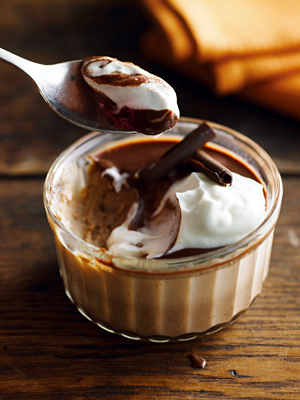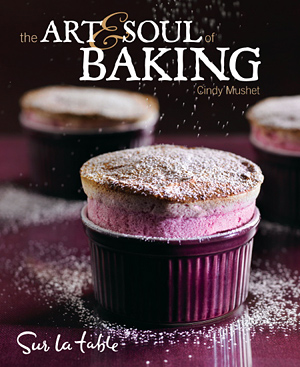Why: The class covers the following: Versatile Bread Dough -- Spongecake -- Chocolate Toffee Scones -- Classic Apple Pie with Flaky Crust -- Pumpkin Spice Cake with Maple Cream Cheese Frosting and Caramel Sauce -- Chocolate Soufflé with Cocoa Nib.
Want to see what an entry in the book looks like? Here's the recipe for luscious Duo-Tone Chocolate Pots de Crème reprinted by permission from The Art and Soul of Baking.

Duo-Tone Chocolate Pots de Crème
Serves 6
Milk chocolate is often overlooked in the quest for the newest and darkest offerings, but it’s still a favorite—with kids and adults alike. Its presence is a surprise in this recipe, as the luscious milk chocolate custard is hidden under a thin layer of warm chocolate ganache. So although the spoon dips into a dark surface, it comes out with a lighter custard full of the malty, caramel-like qualities of milk chocolate. The interplay of cool, milky sweetness against warm, dark richness is sublime.
Equipment:
Medium Bowl, Small Bowl, Medium Saucepan, Whisk, Fine-Mesh Strainer, Pitcher or Large Measuring Cup with Spout, Six (6-Ounce) Ceramic Ramekins or Custard Cups, Large Roasting or Baking Pan, Tongs, Cooling Rack, Small Saucepan, Silicone or Rubber Spatula
Ingredients
Custard:
7 ounces good-quality milk chocolate, finely chopped
1 large egg
4 large egg yolks
1¼ cups (10 ounces) heavy whipping cream
1¼ cups (10 ounces) whole milk
¼ cup (1¾ ounces) sugar
Ganache:
1½ ounces semisweet or bittersweet chocolate (up to 64 percent cacao)
5 tablespoons (2½ ounces) heavy whipping cream
Softly Whipped Cream (page 416) and milk or dark chocolate curls (page 428), for serving
1. Preheat the oven to 325°F and position an oven rack in the center.
2. Make the custard: Place the chopped chocolate in the medium bowl. Combine the egg and egg yolks in the small bowl. Heat the cream, milk, and sugar in the medium saucepan over medium heat until just before the mixture boils. Immediately pour it over the chopped chocolate. Let it sit for 1 minute, then whisk gently but thoroughly to completely blend the mixture. Add the whole egg and yolks, whisking to incorporate thoroughly.
3. Strain and bake the custard: Pour the custard through the strainer into the pitcher. Place the custard cups in the large roasting pan, making sure they don’t touch, and divide the warm custard among them. Pull out the oven rack and place the pan on the rack; then remove one of the cups, pour enough hot tap water (not boiling) into that area to come halfway up the sides of the cups, and replace the cup. Cut a piece of foil large enough to fit just inside the edges of the pan, then lay the foil across the top of the cups, making sure it doesn’t touch the custard. You may need to smooth and flatten the foil on the counter if any wrinkles touch the custard. Gently push the rack back into the oven, shut the oven door, and bake the custards for 50 to 60 minutes, just until the edges of the custards are set—there should still be a dime-size liquid area in the very center of the custard (test by gently tapping the side of the pan).
4. Remove the foil and then the pan from the oven, being careful not to tilt the pan and splash water on top of the custards. Set the pan on a heatproof surface. Use the tongs (or your hand protected by a kitchen towel) to immediately remove the cups from the water bath and place them on a rack to cool to room temperature, about 40 minutes. Cover with plastic wrap and refrigerate until cold, at least 4 hours or overnight.
5. Add the ganache layer: Place the chopped semisweet chocolate in the cleaned small bowl. Heat the cream in the small saucepan over medium heat just until it begins to simmer (do not allow the cream to boil and evaporate). Immediately pour the cream over the chocolate. Allow the mixture to sit undisturbed for 1 minute, then gently stir with the spatula until thoroughly blended and smooth. Spoon a tablespoon of ganache onto the surface of each custard, then gently swirl each cup until the dark chocolate completely covers the custard. (If the ganache seems too thick to spread easily, heat another tablespoon of cream and add it to the mixture).
6. Serve the custards immediately, while the ganache is still warm, or refrigerate up to 1 hour. As the ganache chills, it begins to harden and pull away from the sides of the cup, losing its silken texture and exposing the custard beneath, thereby spoiling the surprise. Serve each with a spoonful of whipped cream, topped with a scattering of chocolate curls if you like.
What the Pros Know
Milk chocolate and white chocolate are different from dark chocolate in two main ways. They have very little or no dark cocoa solids, otherwise known as cacao mass, which provide the dark color and thick viscosity of dark chocolate. In addition they have milk powder added. Because of these differences, milk and white chocolate cannot be substituted for dark chocolate in most recipes. Sometimes, however, they can be substituted for each other. In this recipe, for instance, you could create a white chocolate custard by substituting it for the milk chocolate in the ingredient list. Keep the dark chocolate ganache topping the same. If you want to add an additional layer of flavor, infuse the milk and cream with the spice, herb, or flavoring of your choice and let it sit for 15 to 20 minutes (or until you like the flavor) before reheating the mixture, pouring it through a strainer over the chocolate, and continuing with the rest of Step 1.
 Every few years an amazing baking book comes along. You may already have a tried and true favorite, but if you are still on the hunt I have a suggestion for you, check out The Art and Soul of Baking from Sur La Table. Beginning bakers and seasoned experts alike will find something to love about the book. With glowing recommendations on the back cover from baking authorities and pastry chefs such as Peter Reinhart, David Lebovitz, Sherry Yard, Emily Luchetti, Dorie Greenspan and Flo Braker and an introduction from Alice Medrich you know it must be good, right?
Every few years an amazing baking book comes along. You may already have a tried and true favorite, but if you are still on the hunt I have a suggestion for you, check out The Art and Soul of Baking from Sur La Table. Beginning bakers and seasoned experts alike will find something to love about the book. With glowing recommendations on the back cover from baking authorities and pastry chefs such as Peter Reinhart, David Lebovitz, Sherry Yard, Emily Luchetti, Dorie Greenspan and Flo Braker and an introduction from Alice Medrich you know it must be good, right?